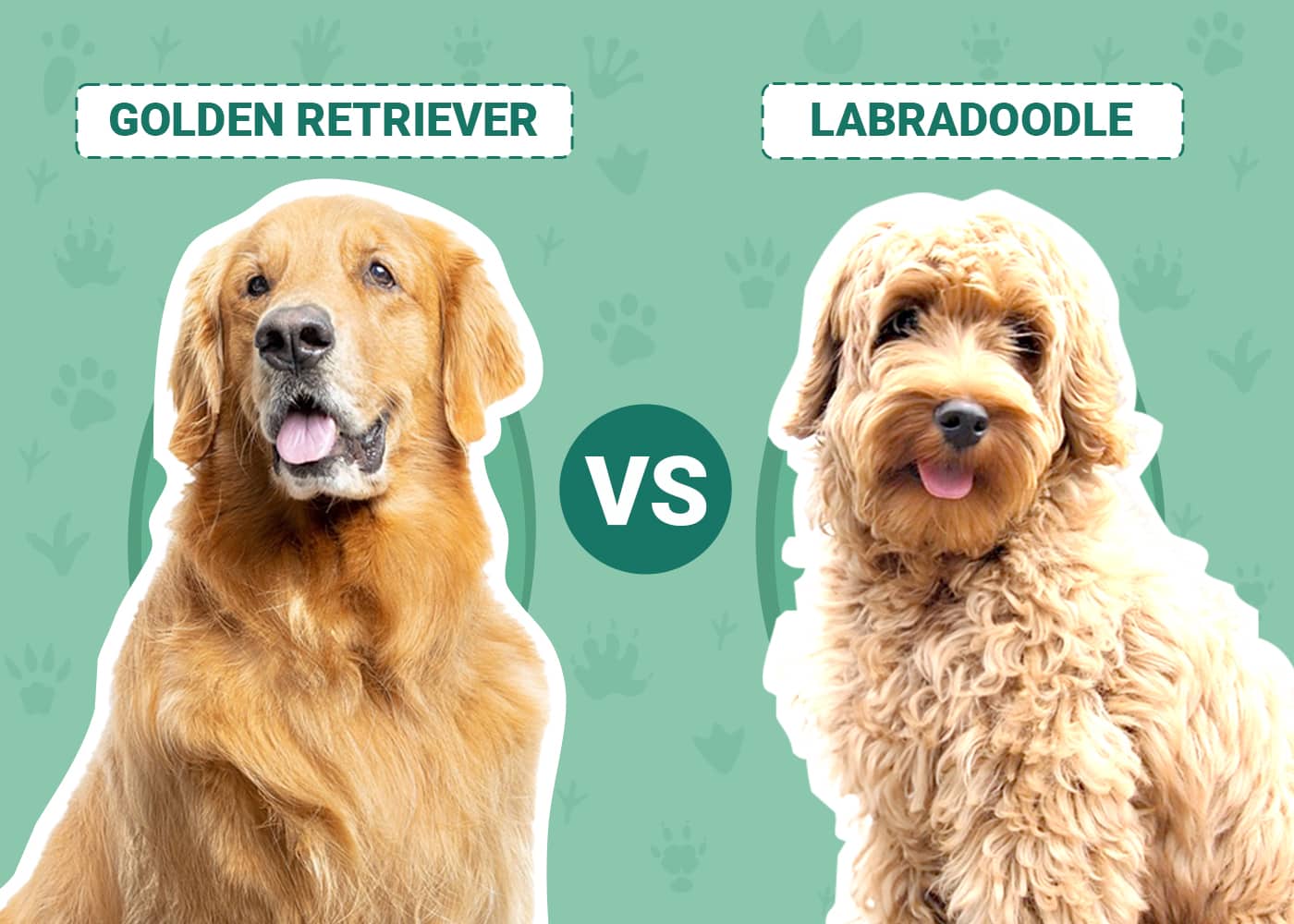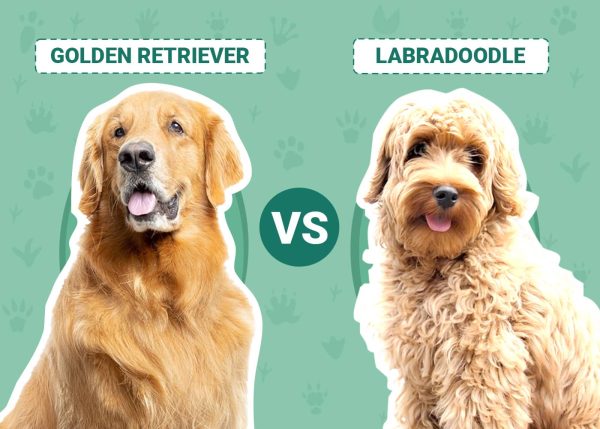Click to Skip Ahead
Friendly, playful, and loyal, Golden Retrievers are among the most popular dogs in the US. They are quick to follow commands, eager to please their owners, and fun to have around. Labradoodles are just as caring, gentle, and intelligent. After all, they’re a crossbreed between a Poodle and a Labrador! Both canines are often used as service, work, and guard dogs. So, if you’re looking for a family doggo with a good heart, these two breeds will be a perfect pick.
Which four-legged bud should you adopt, though? What are the key characteristics of Golden Retrievers and Labradoodles? That’s exactly what we’re here to find out! Today, we’ll go over the differences and similarities in appearance, size, height, lifespan, exercise recommendations, grooming needs, and, of course, personalities. If you’re torn between a Golden and a Labrador/Poodle mix, this guide will help you make the right choice!
Visual Differences
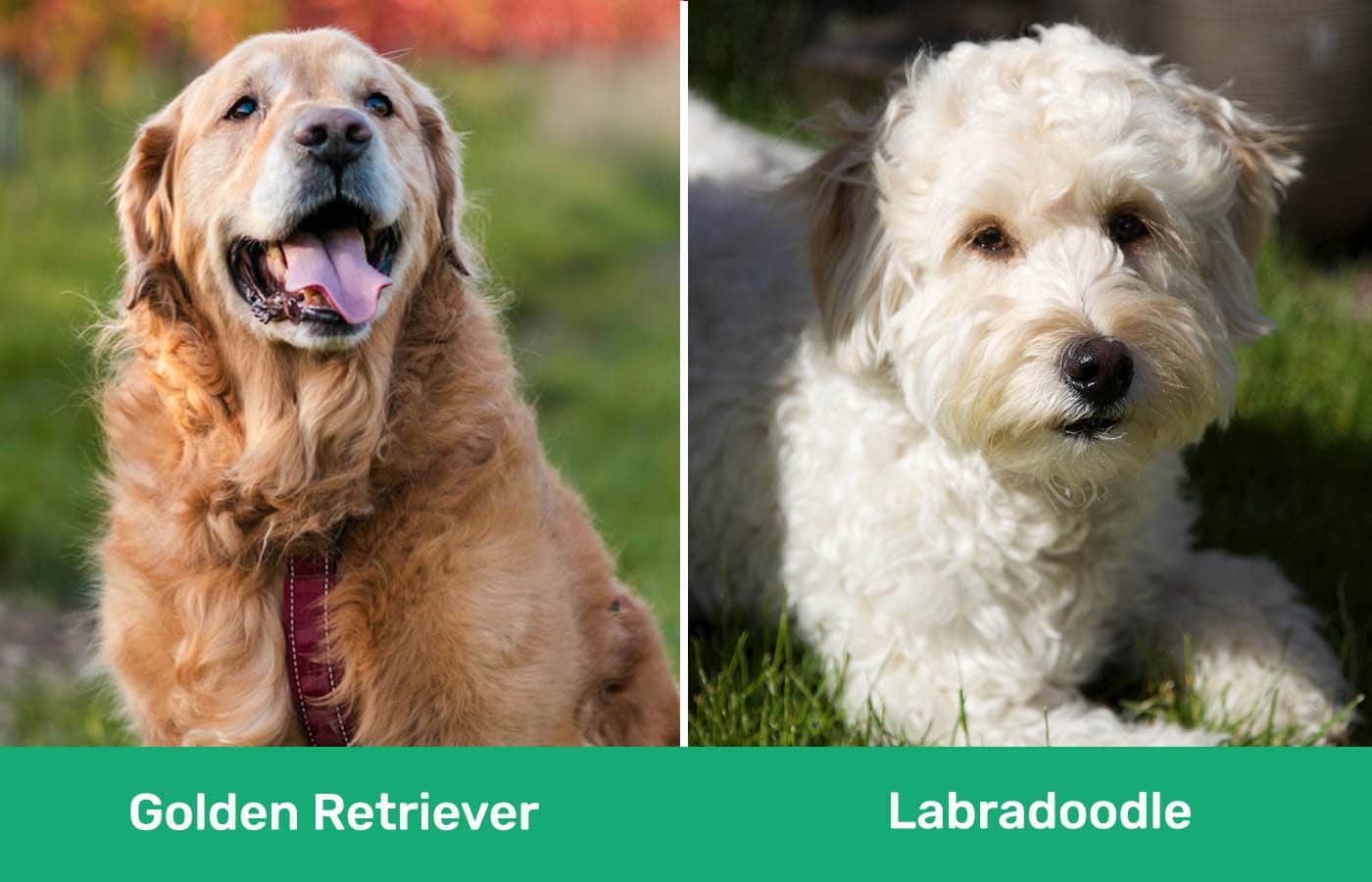
At a Glance
- Average height (adult): 5–24 inches
- Average weight (adult): 55–75 pounds
- Lifespan: 10–12 years
- Exercise: 1–2 hours a day
- Grooming needs: Moderate
- Family-friendly: Very
- Patience with children: High
- Other pet-friendly: Yes
- Protective nature: Moderate
- Trainability: Loyal, intelligent, outgoing, quick to follow commands
- Average height (adult): 14–25 inches
- Average weight (adult): 15–65 pounds
- Lifespan: 12–14 years
- Exercise: 1–1.5 hours a day
- Grooming needs: Low/Moderate
- Family-friendly: Very
- Patience with children: Moderate
- Other pet-friendly: Yes
- Protective nature: High
- Trainability: Loyal, curious, playful, goofy
Golden Retriever Overview
Goldens are beautiful, sweet-tempered dogs, but they’re also hard workers. Developed back in the 19th century in Scotland to serve as gundogs, these canines excel at field work, hunting, and guarding. Today, they are often used as service dogs; search-and-rescue missions are another area where Golden Retrievers have proven to be highly effective. This might come as a surprise, but this doggo is a crossbreed between Yellow Retrievers and Tweed Water Spaniels.
In 1908, a Golden Retriever made a debut at a dog show in the UK, and after that, the breed found its way to Canada and the US. It managed to win over the crowd with an easygoing, obedient character, strong build, golden coat, straight muzzle, and trusting nature. In the States, Goldens participated in countless competitive events, and, very soon, they became one of America’s favorite breeds.
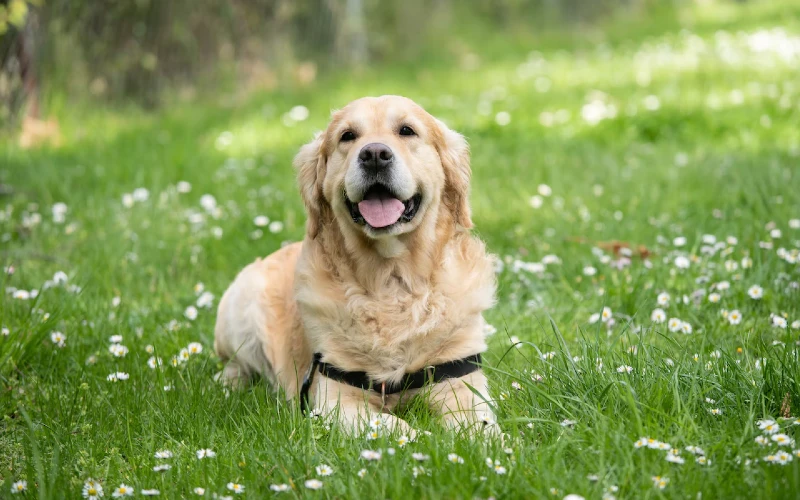
Personality / Character
Eager to please and devoted to their human parents, Golden Retrievers are both loyal and smart. Despite the slightly above-average size and muscular body, these four-legged buds have a childish (or, rather, puppyish) behavior that doesn’t go away when the pup turns into an adult. They’re always happy to meet new people, rarely bark at strangers, and create very strong bonds. Plus, while you should always provide supervision, Goldens are very good around children.
They’re tolerant, patient, and ready to rumble. The gentle personality turns Golden Retrievers into the ultimate sweethearts.
Training / Exercise
The Golden is a very energetic dog. It likes to stay busy: that’s why it’s so important to play and exercise with this doggo for at least an hour per day (ideally, up to two hours). Physical and mental stimulation is how you keep this fine canine citizen happy. We’re talking about walking, jogging, hiking, and playing with toys. And how do you train this pet? Golden Retrievers love to follow commands and take almost no time to learn new tricks.
Also, don’t forget to socialize them at an early stage. This way, the dog will be even more open, welcoming, and friendly toward strangers.
Appearance
Golden Retrievers are the epitome of an athletic, hardworking, and energetic dog. Males often reach 24 inches in height and weigh up to 75 pounds, which puts them into the mid-size category. But it’s the coat that has brought this breed fame. Just like the name suggests, the double fur is golden (it can be light, dark, or even white or red). It’s always dense but can be wavy or straight. The muzzle is straight; the head is broad, while the ears are quite short.
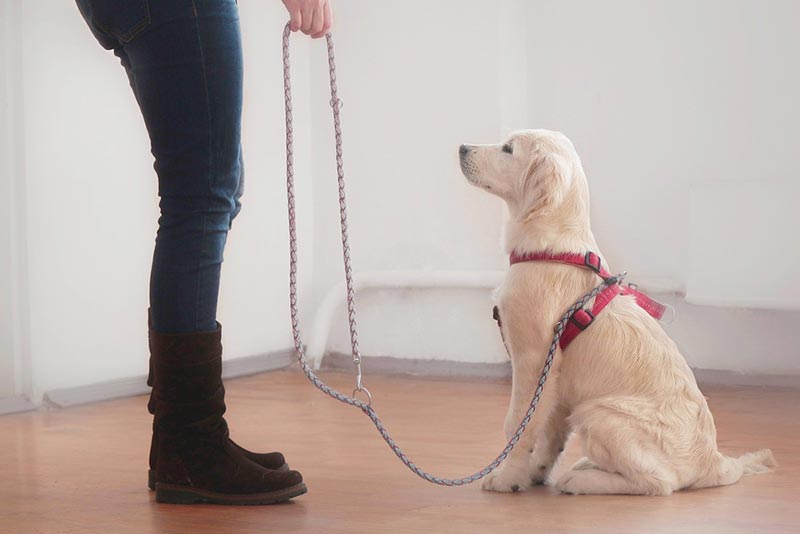
Health / Care
Goldens are strong, healthy dogs that live for up to 12 years. They’re not immune to diseases, though. Here’s a list of the most common Golden Retriever health issues:
- Hot spots/skin infections. Inflamed spots on the skin are common in Golden Retrievers because of the thick coats. Plus, they like to swim, opening themselves up to potential yeast/bacterial infections. Thankfully, this can be fixed with meds.
- Atopic dermatitis. This is another inflammatory condition that affects the skin, making it itch. Atopy is often caused by food allergies, fleas, mites, and mildew. It makes the doggo scratch, which results in hair loss, a rash, or even trauma. Early vet visits will help fix that.
- PU and PRA. When the eyes develop cysts, it’s called pigmentary uveitis. Usually, this happens when the dog turns five years old. To avoid cataracts, seek medical treatment for the pet. PRA is a much more serious condition, and, over time, it makes the doggo blind. Sadly, there are no remedies against that.
- The lack of thyroid hormones leads to low energy, sudden weight gain, thin fur, and various infections. Hypothyroidism can be controlled with vet-approved meds. The sooner it’s diagnosed, the better.
- HSA and lymphoma. Hemangiosarcoma (HSA) is one of the most aggressive types of cancer that targets the heart, liver, or spleen. The same goes for lymphoma: it starts in the nodes (usually on the dog’s neck, thighs, and knees) but spreads very quickly.
- Subvalvular aortic stenosis (SAS) is a genetic heart condition that Golden pups inherit from their biological parents, and the best way to avoid it is to buy the dog from a reputable breeder.
- Ear infections. Clean your pet’s ears once a month and keep them dry—that will help avoid most ear infections, including the ones caused by wax build-up.
- The side effects of joint and elbow dysplasia include limping and difficulty walking/running. With luck, meds and supplements will get the doggo back on its feet. If not, surgery might be the only option.
Grooming
These dogs are heavy shedders, and they do that once or twice in 12 months and moderately for the rest of the year. If you brush the coat 1–2 times a week with a slicker brush, you’ll be able to protect the furniture and the carpets from excessive dog hair. However, in spring and fall, when the season “hits”, you’ll have to brush it seven days a week. Bathing helps get rid of dead fur. Also, remember to trim the pet’s nails (once a month) and clean its teeth and ears regularly.
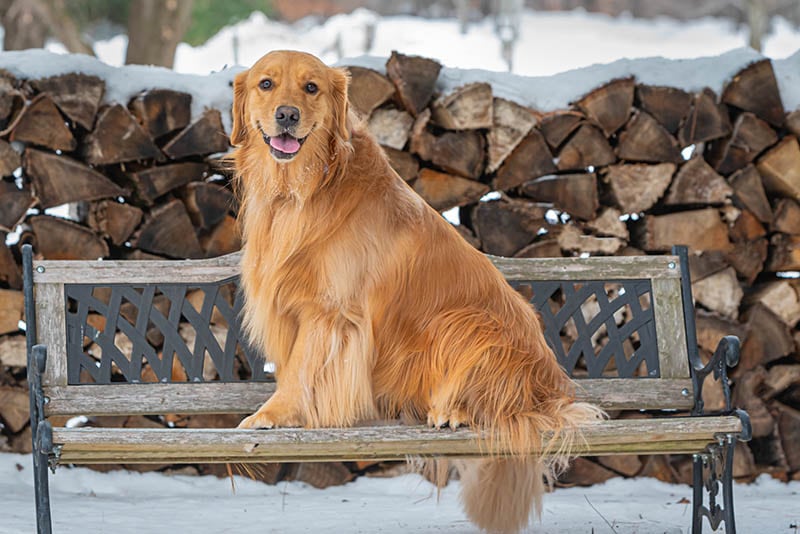
Suitable for:
This breed is a match made in Heaven for a family that’s ready to welcome an energetic, devoted, and sweet dog and spend most of their free time with it. Golden Retrievers need quite a lot of exercise and mental stimulation to stay happy. The playful, pup-like attitude, readiness to follow commands, and trademark golden coat make these dogs a sure pick. They are heavy shedders, though!
- Incredibly affectionate and loyal
- Playful, energetic, acts like a pup
- Eager to please, easy to train
- Needs up to two hours of exercise
- Tends to shed a lot
Labradoodle Overview
These dogs are a mixed breed between Retrievers and Poodles. The first mentions date back to 1955, but it was the late 60s when these dogs started to become popular. In the 80s, Australian breeders put a lot of effort into Labradoodle development, with an attempt to create a doggo that’s strong as a Labrador yet doesn’t shed as much. For that reason, they started adding Spaniels into the mix.
Today, there are two distinctively different types of Labradoodles: the American dogs and the Australian ones. And then we have the Miniature Labradoodles, the love child between a Labrador and a tiny Poodle! Sadly, none of these breeds are recognized by the AKC or the British Kennel Club. Still, they’re all quite popular.

Personality / Character
Witty, playful, and affectionate, Labradoodles are loved for their charming and cheerful nature. In many ways, they are the ultimate family dogs because they’re obedient, full of energy, and like to play with little kids and fellow pets. Sometimes, these canines can be a bit stubborn. But, if you socialize them at a young age, that will bring out the best in Labradoodles.
All in all, Doodles are almost an exact copy of Goldens but with a bit more silliness (the good kind). They’re slightly less tolerant of kids, but this can be fixed with proper training.
Training / Exercise
For a Labradoodle, an hour of exercise is more than enough. These dogs are eager to follow commands and catch on quickly, which makes playing and training with them a joy. Be patient, consistent, and don’t forget to reward the doggo for a job well done—that’s how you create a strong bond.
Appearance
Strong chests, sturdy backs, longer-than-average legs, and slim waists are the distinctive characteristics of Labradoodles. Also, they have a single-layer coat, and, depending on the dog, the fur can be flat, straight, fleecy, or wooly. In contrast to Golden Retrievers, Labradoodles come in a wide range of colors, such as blue, apricot, black, and white. As for the size, it greatly depends on the Poodle.
A standard-size doggo can weigh up to 65 pounds; Miniature Labradoodles rarely go over 15 pounds, though. The same logic applies to the height: it ranges from 14 to 25 inches.
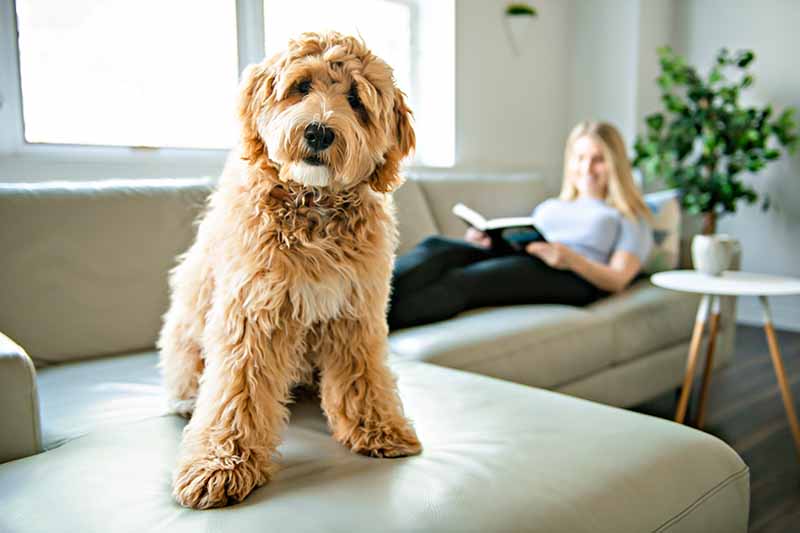
Health/Care
Just like Labradors, Labradoodles are healthy, well-built dogs. But they’re still prone to certain diseases. Here’s a quick look:
- PRA and glaucoma. PRA targets the retina and often leads to blindness. Glaucoma, in turn, affects the optic nerve. As for cataracts, when left untreated, it makes the dog’s eyes hurt and go blind. Consult with a veterinarian to come up with the right surgery for the pet.
- Heart diseases. Arrhythmia and DCM are the most common causes of heart conditions in Labradoodles. The side effects include coughing, weakness, fainting, and difficulty breathing. A screening will reveal what kind of issue the doggo is dealing with and help come up with a treatment.
- Addison’s disease. Weight loss, vomiting, diarrhea, and shaking are all signs of hypoadrenocorticism. This happens when the dog’s body fails to produce enough hormones (aldosterone and cortisol). This condition can be treated with DOCP.
- Dysplasia and luxating patella. The side effects of hip/elbow dysplasia are similar to those of Golden Retrievers.
- Von Willebrand’s disease. It’s when the blood fails to clot, which leads to bleeding from the dog’s nose, mouth, or various tracks. Clotting agents and blood transfusions: that’s the best course of action here.
Grooming
Minimal shedding is arguably the biggest advantage that Labradoodles have over Goldens. You’ll still have to stick to a regular grooming schedule, of course. This is especially true if the dog’s coat is straight. Brush it 2–3 times a week, and that should keep the fur in tip-top shape.
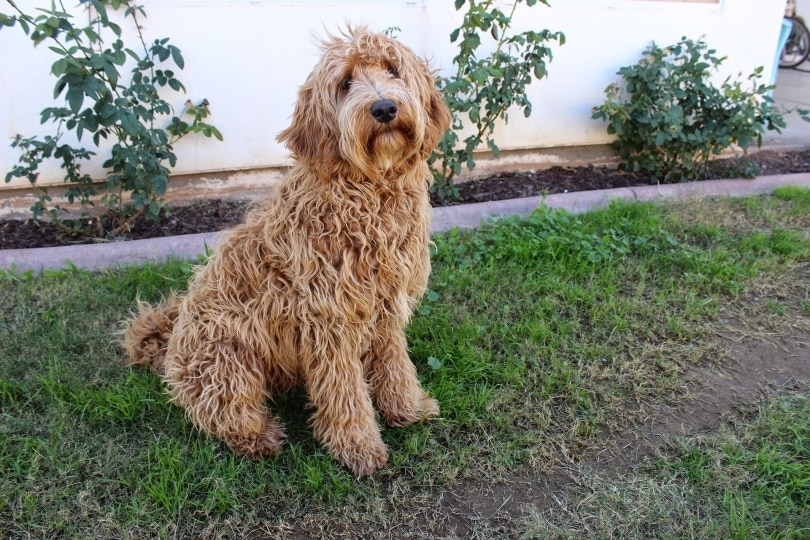
Suitable for:
Just like Golden Retrievers, Labradoodles are often picked as family dogs. They are not only cute but also loyal, intelligent, and protective of their humans. As long as you have enough time to keep the four-legged chap mentally and physically active, you’ll get yourself a new best friend. Show your Doodle the love it deserves, and you’ll get a tenfold return on investment!
- Goofy, playful, and enthusiastic
- Lives for up to 14 years
- Very easy to groom
- Requires patience in training
- Not recognized by the AKC
Which Breed Is Right for You?
There you have it—our detailed comparison of Goldens and Labradoodles! We’re happy to say that both breeds are smart, loving, and affectionate. Goldens and Doodles are the exact opposite of barky, clingy, or aggressive. They are devoted, obedient, and full of joy. Big families in the market for a furry chap to join their ranks will be pleased no matter which dog they choose. Golden Retrievers do need a bit more exercise, though; their grooming needs are slightly higher, too.
Labradoodles, in turn, are more protective and live longer, but they’re also more curious and a bit goofy. Both chaps are equally friendly toward humans and pets. In many ways, it all comes down to appearance. Goldens are generally heavier, while Labradoodles are just a smidge taller. However, if you opt for a miniature Doodle, it can be as tiny as 15 pounds and inches. In any case, make sure you have enough time and energy to keep up with these lovely boys and girls!
See Also:
- Golden Retriever vs Border Collie: Notable Differences (With Pictures)
- Double Doodle vs. Labradoodle: Key Differences (With Pictures)
Featured Image Credit: (T) Emil Priver, Unsplash | (B) Justin Sienkiewicz, Shutterstock

